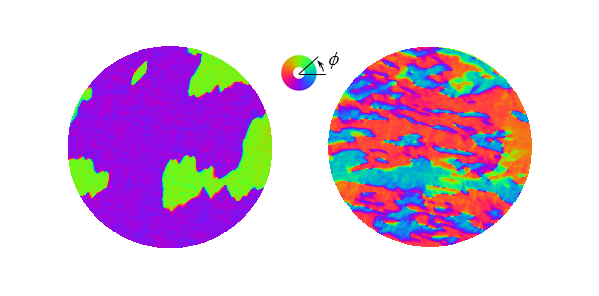The ceramic perovskite PMN-PT is a relaxor ferroelectric, whose piezoelectric properties are widely used in commercial actuators (PMN-PT = 0.68Pb(Mg1/3Nb2/3)O3–0.32PbTiO3). In standard operation, the strain varies continuously with applied voltage, and can be normal or shear depending on the cut of the crystal. If cycling the applied voltage yields ferroelectric domain switching then the resulting discontinuous changes of strain can be used to drive magnetic switching in a thin overlying ferromagnet, thus electrically writing magnetic information. Surprisingly, it has been hitherto assumed that these discontinuous changes of in‑plane strain are wholly normal, even though a shear component can be identified via the rhombohedral unit cell parameters.
We used a ferromagnetic film of nickel as a sensitive strain gauge for single-crystal PMN-PT. While varying the voltage across this crystal, we first made macroscopic magnetic measurements of the film using vibrating sample magnetometry. Each of the corresponding microscopic measurements involved combining two XMCD‑PEEM images to form a magnetic vector map. (PEEM is photoemission electron microscopy, the magnetic contrast comes from x-ray circular magnetic dichroism or XMCD, and the resolution was ~135 nm given our 50 µm‑diameter field of view.) Confusingly, macroscopic and microscopic measurements both gave the initial false impression that ferroelectric domain switching rotated magnetic domains by 90°, implying no shear component. This is because the macroscopic measurements averaged over both clockwise and anticlockwise magnetic domain rotations; and the good angular resolution of the microscopic measurements could not be visually resolved using the colour wheel (see image). However, a pixel‑by‑pixel comparison revealed that the magnetic switching angles fell well short of 90°, consistent with our 62.6° prediction from the PMN-PT unit‑cell geometry. This prediction involved identifying new principal axes of strain via the Mohr’s circle construction, which is taught to our second‑year undergraduates.
The electrically driven sub-90° magnetic switching implies the possibility of devices in which binary data are independently written using a magnetic field and an electric field, as originally envisaged for multiferroic materials that are both ferromagnetic and ferroelectric. More generally, our new twist on a well known ferroelectric material means that it should in future become normal to consider the shear strain that arises when low‑symmetry ferroelectric domains undergo switching.
Image caption: 50 µm‑diameter magnetic maps of a 10 nm‑thick Ni film, before (left) and after (right) imparting strain via voltage-driven ferroelectric‑domain switching in the underlying PMN-PT substrate. Colour wheel gives superficial impression that magnetization was up (green) and down (purple), then left (red) and right (blue). Data obtained at Diamond Light Source.
M. Ghidini, R. Mansell, F. Maccherozzi, X. Moya, L. C. Phillips, W. Yan, D. Pesquera, C. H. W. Barnes, R. P. Cowburn, J.-M. Hu, S. S. Dhesi and N. D. Mathur. “Shear-strain mediated magnetoelectric effects revealed by imaging”, Nature Materials (2019)

